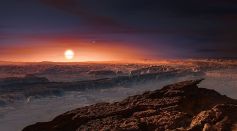Tags: European Southern Observatory

As 3I/ATLAS Meets the Sun, Astronomers Fear a Cosmic Twist Awaits

VLT Survey Telescope Captures Running Chicken Nebula's Spectacular Detail, a Stellar Holiday Treat from ESO

Starburst Galaxy Photo Shows A Golden Swirling Cloud of Gas

European Southern Observatory Finds New Exoplanet Orbiting Proxima Centauri; Is Proxima d Lighter Than Earth?
Now You See Me, Now You Don’t: Massive Telescope Captures Mystery Cosmic Disappearance
ESO Discovers A New Black Hole Closest to the Earth Visible to the Naked Eye, Suggesting Millions are Yet to be Found
ESO VISTA Telescope Captured Infrared Gigapixel Image Of Small Magellanic Cloud (SMC)
Dark Matter: No Such Evidence Found In Earlier Galaxies Of The Universe, Study Finds
The ESA Finds Champagne Nebula And Brighter Sets of Stars
Astronomers Capture the Most Detailed Images Yet of the Beautiful Medusa Nebula
Stellar Duo Fated to Meet a Supernova End—Twin Stars Discovered in Henize 2-428
Most Popular

How AI Is Used in Weather Prediction: Smarter Forecasting Through Machine Learning

De-Extinction vs. Conservation Science: Which Approach Protects Biodiversity Most Effectively?

Geoengineering and Climate Intervention Science: Can We Really Engineer a Cooler Planet?

The Future of Clean Tech: Exploring the Next Generation of Renewable Energy Breakthroughs





